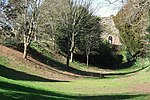Exeter Central railway station
DfT Category C1 stationsFormer London and South Western Railway stationsPages with no open date in Infobox stationRailway stations in ExeterRailway stations in Great Britain opened in 1860 ... and 3 more
Railway stations served by Great Western RailwayRailway stations served by South Western RailwayUse British English from December 2016

Exeter Central railway station is the most central of the stations in the city of Exeter, Devon, United Kingdom. It is 171 miles 30 chains (275.8 km) down the line from London Waterloo. The station is smaller than Exeter St Davids on the west side of the city. Great Western Railway manages the station and operates most services, with South Western Railway providing the rest. From 1860, when it was opened by the London and South Western Railway, until 1933, when it was rebuilt, it was known as Exeter Queen Street.
Excerpt from the Wikipedia article Exeter Central railway station (License: CC BY-SA 3.0, Authors, Images).Exeter Central railway station
The Crescent, Exeter St Thomas
Geographical coordinates (GPS) Address Nearby Places Show on map
Geographical coordinates (GPS)
| Latitude | Longitude |
|---|---|
| N 50.7264 ° | E -3.533 ° |
Address
Exeter Central
The Crescent
EX4 3SB Exeter, St Thomas
England, United Kingdom
Open on Google Maps










